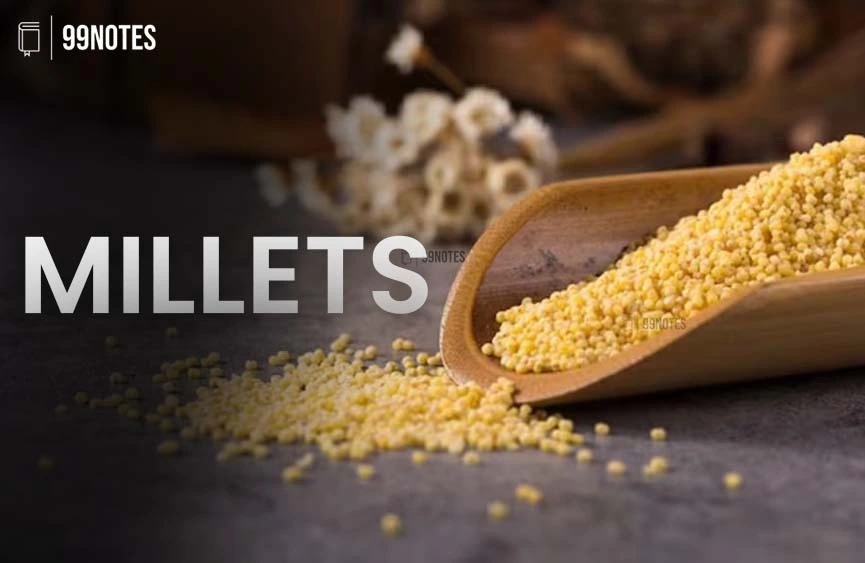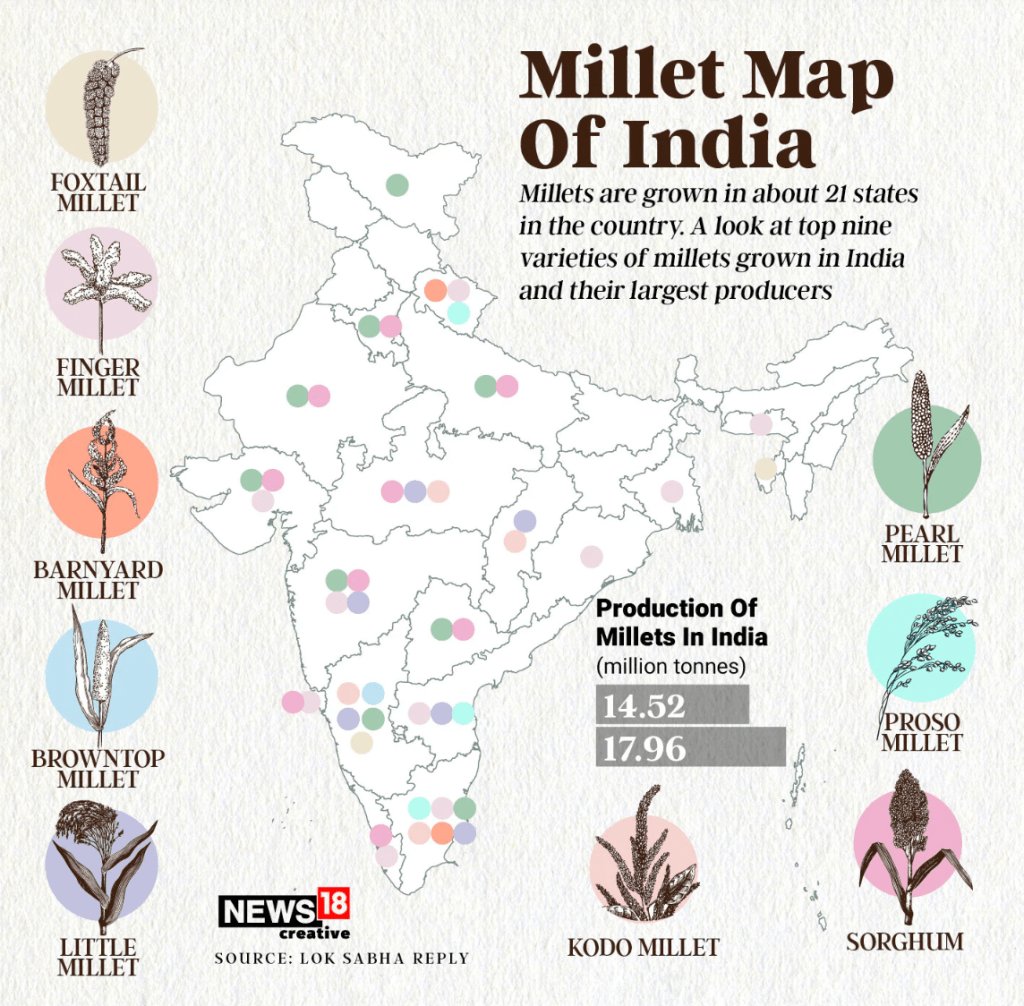Millets
These are also known as ‘nutria-millets/nutria-cereals’: high nutritional value having great potential in contributing substantially to food and nutritional security of the country.
Millets in India:
- The three major millet crops currently grown in India are jowar (sorghum), bajra (pearl millet) and ragi (finger millet).
- Along with that, India grows a rich array of bio-genetically diverse and Indigenous varieties of “small millets” like kodo, kutki, chenna and Sanwa.
- Major producers: Rajasthan, Andhra Pradesh, Telangana, Karnataka, Tamil Nadu, Maharashtra, Gujarat and Haryana.
- Total Production ~ 18MT in 2021.
|
Crop |
Conditions | States in India |
India’s Position |
| Jowar: or Sorghum. |
|
Grown in semi-arid areas of central and southern India.
|
|
| Bajra: Hardy crop (can resist frequent dry spells) |
|
|
|
| Maize: food as well as fodder |
|
Not concentrated in any specific region.
Yields:
|
|
| Ragi:
Rich in Fe, Ca, fibre, and micro-nutrient. |
|
Important Producers: Karnataka (largest), Tamil Nadu; and Uttarakhand, Sikkim, Jharkhand and Arunachal Pradesh |
Pneumonic (the learning name): “Jowar-Bajra-Ragi: White-Brown-Red” helps recall key millets through their grain colours. Jowar (sorghum) is typically white, Bajra (pearl millet) is brown or greenish-grey, and Ragi (finger millet) is red.
Maize:
Maize, also known as corn, is a global powerhouse crop with a fascinating history and diverse uses. It is one of the most versatile emerging crops having wider adaptability under varied agro-climatic conditions. Globally, maize is known as the queen of cereals because it has the highest genetic yield potential among cereals.
Advantages of Maize utilisation:
Staple crop for many – having Export potential
- Third-largest cereal produced globally: Feeds millions and fuels economies in the Americas, Africa, and Asia.
- Versatile Staple: From tortillas and popcorn to animal feed and biofuels, maize offers a multitude of applications.
Nutritional Profile:
- Energy Booster: Rich in carbohydrates for energy, particularly in developing countries.
- Incomplete Protein: Lacks certain essential amino acids, requiring a balanced diet with other protein sources.
- Vitamins and Minerals: Provides some vitamins and minerals like B vitamins and potassium.
Commercial Value
- Production of Bio-ethanol: It can be used to produce bio-ethanol.
Future Trends:
- Biofortified Varieties: Developing crops with higher protein and micronutrient content to address nutritional deficiencies.
- Precision Agriculture: Optimizing water and fertilizer use for efficient and sustainable production.
- Crop Diversification: Exploring alternative crops and promoting sustainable farming practices.
Challenges and Concerns:
- Resource Intensive: Demands significant water and fertilizer, raising sustainability concerns.
- Monoculture Risks: Overreliance on specific varieties increases pest and disease susceptibility.
- Nutritional Deficiencies: Overdependence on maize in some regions can lead to protein and micronutrient deficiencies.
Overall, Maize is a vital crop for global food security, economic development, and diverse industries. Addressing challenges and promoting sustainable practices is crucial for its future.
Case Study: Kodo and Kutki Millet Cultivation:
- An International Fund for Agricultural Development (IFAD) supported an initiative to revive its cultivation in the year 2013-14 in the Dindori district of MP started with 1,497 women farmers from 40 villages – mostly from the Gonda and Baiga tribes.
- Seed and Training: The identified farmers weresupplied with good-quality seeds and trained by scientists from the Jawaharlal Nehru Agricultural University in Jabalpur and the local Krishi Vigyan Kendra – on-field preparation, line-sowing (as opposed to conventional broadcasting by hand) and application of compost, zinc, bavistin fungicide and other specific plant protection chemicals.
- A federation of the farmers’ self-help groups undertook procurement of the produce and also its mechanical de-hulling (the traditional manual pounding process to remove the husk from the grain was time-consuming).
Impact:
- Helped in increasing the number of farmers growing kodo-kutki in the project area to 14,301 in 2019-20.
- Helped in increasing the acreage to 14,876 acres from 700.
- Helped in meeting nutritional goals (fighting malnourishment among children)
- Helped in reviving millet cultivation (crop yields are 1.5-2 times higher than before)
Need for Reviving Millet Cultivation:
Millets have various advantages which makes them a favourable choice for the future.
- Cheaper: Millets are often cheaper to grow than other crops! They need less water, and fertilizer, and thrive in tougher conditions, lowering direct costs. In addition, they can expand usable farmland and reduce the risk of crop failure, saving further. However, specific costs vary depending on context. Overall, millets offer strong potential for more sustainable and cost-effective agriculture.
- Nutritional Security: High protein, fibre, vitamins and minerals like calcium, iron, zinc, phosphorus, magnesium, and potassium.
Ex: Ragi has the highest calcium content among all the food grains.
- Climate Resilient:
- Drought-resistantdue to:
- short growing season(70-100 days, as against 120-150 days for paddy/wheat) and
- lower water requirement(350-500 mm versus 600-1,200 mm).
- Wide capacity for adaptation: Millets can withstand variations in moisture, temperature and the type of soils ranging from heavy to sandy infertile lands.
- Drought-resistantdue to:
- Economic Security: As low investment is needed for the production of millets, these can prove to be a sustainable income source for farmers.
- Tackling Health Issues:
- Millets can helptackle lifestyle problems and health challenges such as obesity and diabetes as they are gluten-free and have a low glycemic index (a relative ranking of carbohydrates in foods according to how they affect blood glucose levels).
- Millets are rich in antioxidants.
- Individuals suffering from celiac disease can easily incorporate various millets into their diets.
- Its high iron content can fight the high prevalence of anaemia in Indian women of reproductive age and infants.
- Commercial Potential
- It acts as both – food and fodder.
- They can form quickly packaged yet nutritious food, which urges more customers to buy them, thus increasing their demand.
- India exports various millets to African countries as well as imports from there.
Challenges in the production of Millet:
Demand Side Challenges
- Cultural Preference for Wheat: Wheat has gluten proteins that swell and form networks on adding water to the flour, making the dough more cohesive and elastic, but millets are gluten-free.
- Subsidy structure: NFSA entitles 5 kg of wheat or rice or millets/person/month at ₹2 and ₹3 per kg, respectively, but procurement is subdued.
- Poor market: there is negligible profitable market or demand and supply chain networks are weak.
- Increased Demand for Mill-processed Food: even the rural population has started perceiving mill-processed rice and wheat as more aspirational.
- Lack of investment in millet product development and promotion/ advertisements.
Supply Side Challenge
- Rain-fed crop: higher chances of crop failure. It is mainly grown in the Rajasthan, Maharashtra and Karnataka.
- Seed development: Not as good as in the case of wheat, rice and other crops.
- Greater margin taken up by middlemen.
- Inefficient government schemes.
- Low crop productivity and high labour intensity.
- Difficult post-harvest operations add to these problems: Processing plants etc.
Government Initiatives for Millets
- Promoting Millets in Food Habits:
- M/o Agriculture declared millets as “Nutri-Cereals”, considering their “high nutritive value” and also “anti-diabetic properties”.
- 2018 was observed as the ‘National Year of Millets”.
- Increase in MSP: It has been included in the PDS too.
- Enhanced production targets – Under NFSM an additional 2 Million Tonnes production target is allocated to millets.
- Input Support:
- provision of seed kits and inputs to farmers,
- building value chains through FPOs and
- Supporting the marketability of millets.
The UNGA adopted an India-sponsored resolution to mark 2023 as the International Year of Millets.







